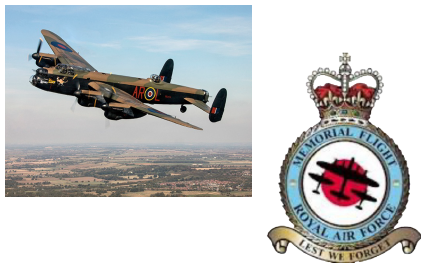WAR GRAVE
JACK SMITHERS (grave 86)
PILOT OFFICER
57 SQUADRON
ABOUT MY LIFE
Born: 21st November 1920
Died: 16th August 1943
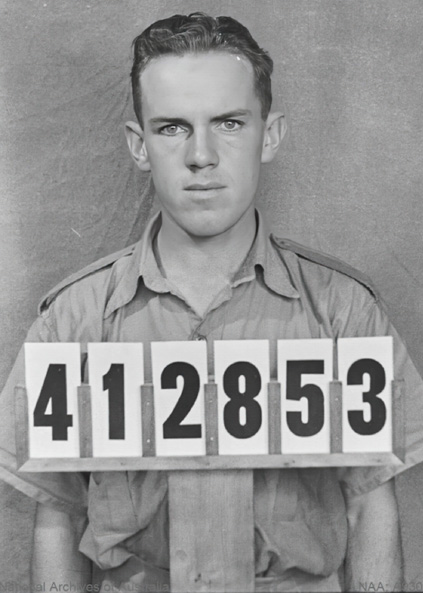
I was from Armidale, New South Wales in Australia, where in civilian life I had been an Assistant Telephonist with the Postmaster General’s Office.
My parents were Louis and Leila Smithers and I was married to my wife, Nancy Rose Smithers, with whom I had two sons, Bevan and Tony.
I joined the Royal Australian Air Force on 20th July 1941 and embarked for England on 24th December 1942, where I would complete the last stages of my pilot training.
MY AIRCRAFT
The Avro Lancaster was a development of the ill-fated Avro Manchester. The twin engine Manchester had been an unmitigated disaster, under-powered and crash prone. Undeterred, the designer Roy Chadwick increased the wingspan and added two more engines. From a disastrous start, the most legendary bomber of all time was born.
From 1942 onwards the Lancaster, together with the Handley Page Halifax, provided the backbone of bomber command. Equipped with four Rolls Royce Merlin engines, the same engine which powered the equally legendary Spitfire, the Lancaster could deliver 18,000 lbs of bombs to targets up to 2500miles away. Later versions of the Lancaster carried even bigger specialist bombs designed by Barnes Wallis of Dambusters fame.
During the Second World War, The Lancaster conducted a total of 156,000 sorties and dropped 608,612 tons (618,378,000 kg) of bombs. A total of 7377 Lancasters were built, of which 3736 were lost to enemy action and accidents.
Today, only 17 complete Lancasters survive, with just two flying examples. The Battle of Britain Memorial Flight’s PA474 and the Canadian Warplane Heritage’s FM213.
Crew: 7
Span: 102 ft
Length: 69 ft 6 in (tail up)
Height: 20 ft 6 in (tail up)
Empty weight: 37,000 lbs
Loaded weight: 65,000 lbs
Engine: 4 x Rolls-Royce Merlin 24 V-12 engines
Engine power: 1,620 hp at 3,000 rpm (1,208 kW)
Maximum speed: 275 mph
Range: 2,530 miles with 7,000 lbs of bombs
Ceiling: 22,000 ft
8 x .303-caliber machine guns
18,000 lbs of bombs
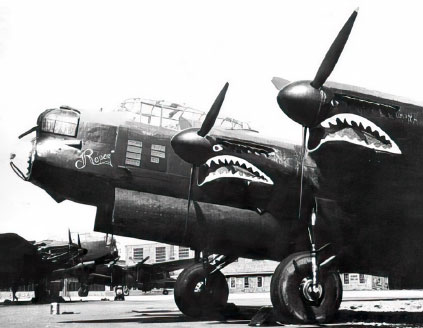
MY ROLE
I was the pilot and captain of this aircraft.
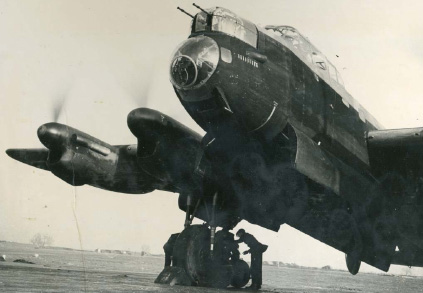
MY SQUADRON
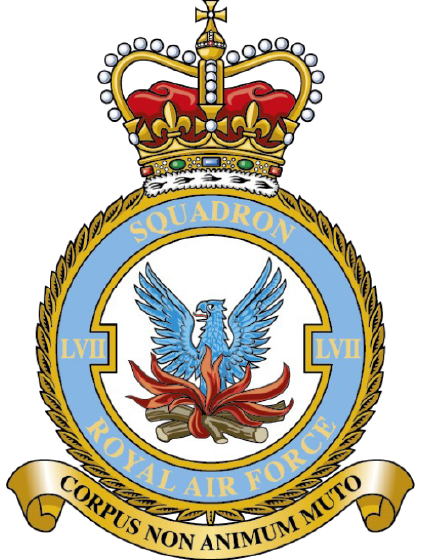
Motto: Corpus non animum muto
‘I change my body not my spirit’
57 Squadron was formed on 8th June 1916 as part of the Royal Flying Corps, initially as a training unit. By October of the same year, they received their first operational type, the Royal Aircraft Factory FE2d, with which they would fly fighter reconnaissance missions in France.
The pace of aviation technological development was rapid and by the middle of 1917, the FE2d was obsolete and the squadron suffered severe losses, on one occasion losing 5 aircraft in a single mission. The situation was only reversed when the squadron received the more advanced Airco DH 4 and switched to a bombing role. Following the end of hostilities, the squadron was disbanded on 31st December 1919.
57 Squadron reformed on 20th October 1931, flying the Hawker Hart in the light bomber role. As the world moved closer to war, they converted to the Bristol Blenheim, a type though by the RAF to be on the cutting edge of light bombers. In reality, it was already obsolete at the outbreak of war and by November 1940, they were flying the Vickers Wellington from RAF Feltwell. In September 1942, they moved to Scampton and converted to the Avro Lancaster, with which they were to fight the remainder of the war.
In the post war years, they first flew the Avro Lincoln, before entering the jet age with the English Electric Canberra. They next moved on to the nuclear armed Handley Page Victor, holding Britain’s nuclear deterrent. When this was passed to the Royal navy, the Victors were used in the air-to-air refuelling role, famously providing fuel to the Vulcans that undertook the Blackbuck missions during the Falklands War.
From 1992-2002, the squadron performed the strategic transport mission with it Lockheed C130 Hercules and in 2008, it switched roles back to its roots as a training squadron, flying the Grob Tutor and Prefect, a role which it performs to this day.
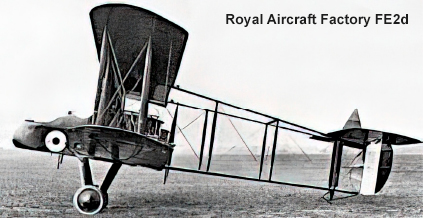
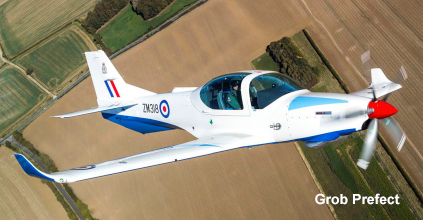
THE ACCIDENT
We were returning from an eight-hour bombing mission to Milan, Northern Italy in Lancaster JA896 of 57 Squadron. It had been our first operational flight and tragically it would also turn out to be his last.
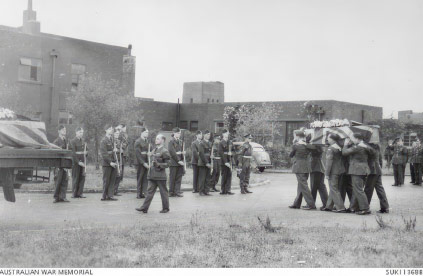
The Guard of Honour assembles at RAF Scampton.
It was just after 4:30 in the morning and we were already in trouble. The port outer engine had failed and to reduce the drag created by a dead engine, the propeller blades were turned edge on to the airflow, in a process known as feathering. Later investigation would show that the engine had suffered some form of over-heating, although the exact nature of the problem was never determined.
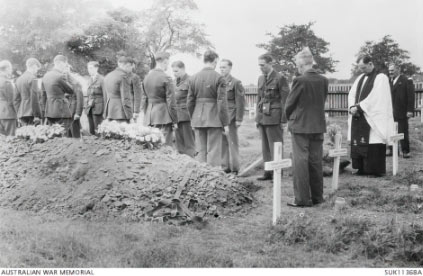
The burial service for Jack Smithers and Ronald Haskins.
A landing with a failed engine is difficult at the best of times, but after a harrowing eight-hour mission it was so much more demanding for a tired pilot. On landing, the Lancaster hit the ground very heavily and bounced. Electing to go around for another approach Jack was too hasty in applying the power. Due to having only three engines there was much greater power on the starboard wing. The aircraft then began to veer to port, a well understood phenomenon, known to the pilots of the day as swing.
Our aircraft’s port wing then struck the ground and spun the aircraft through 180 degrees. Such was the speed of the aircraft that it flipped inverted and caught fire, killing five of its crew and injuring two others in the process. The 57 Squadron accident report summed up as follows:
‘The aircraft made a steady approach on these three engines well in line with the contact strip which was in use at the time. Aircraft bounced badly on touching down and an attempt was made to go around again by opening the three good engines to full power. The resulting swing from this procedure caught the pilot unawares and due to his inexperience resulted in his losing control of the aircraft. Concrete evidence is not possible due to the death of the pilot.’
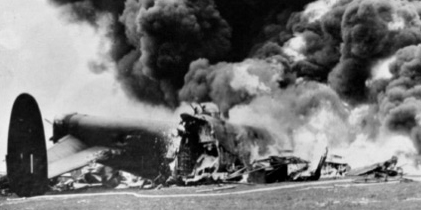
A crashed Lancaster.
CASUALTIES – 16TH AUGUST 1943
Pilot Officer Jack Smithers (Pilot) RAAF (Buried Scampton)
Sergeant Ronald Henry Haskins (Air Gunner) RAAF (Buried Scampton) MORE
ON THIS DAY IN WORLD WAR TWO – 16TH AUGUST 1943
In Bialystok, the Germans enter the Jewish Ghetto and start to deport its 25,000 residents.
In the USSR, Soviet forces take Zhidra, near Bryansk.
Where Next
Visit Lancaster PA474 at the Battle of Britain Memorial Flight RAF Coningsby.
BBMF Visitor Centre, Dogdyke Road, Coningsby, LN4 4SY Telephone: 01522 782040
